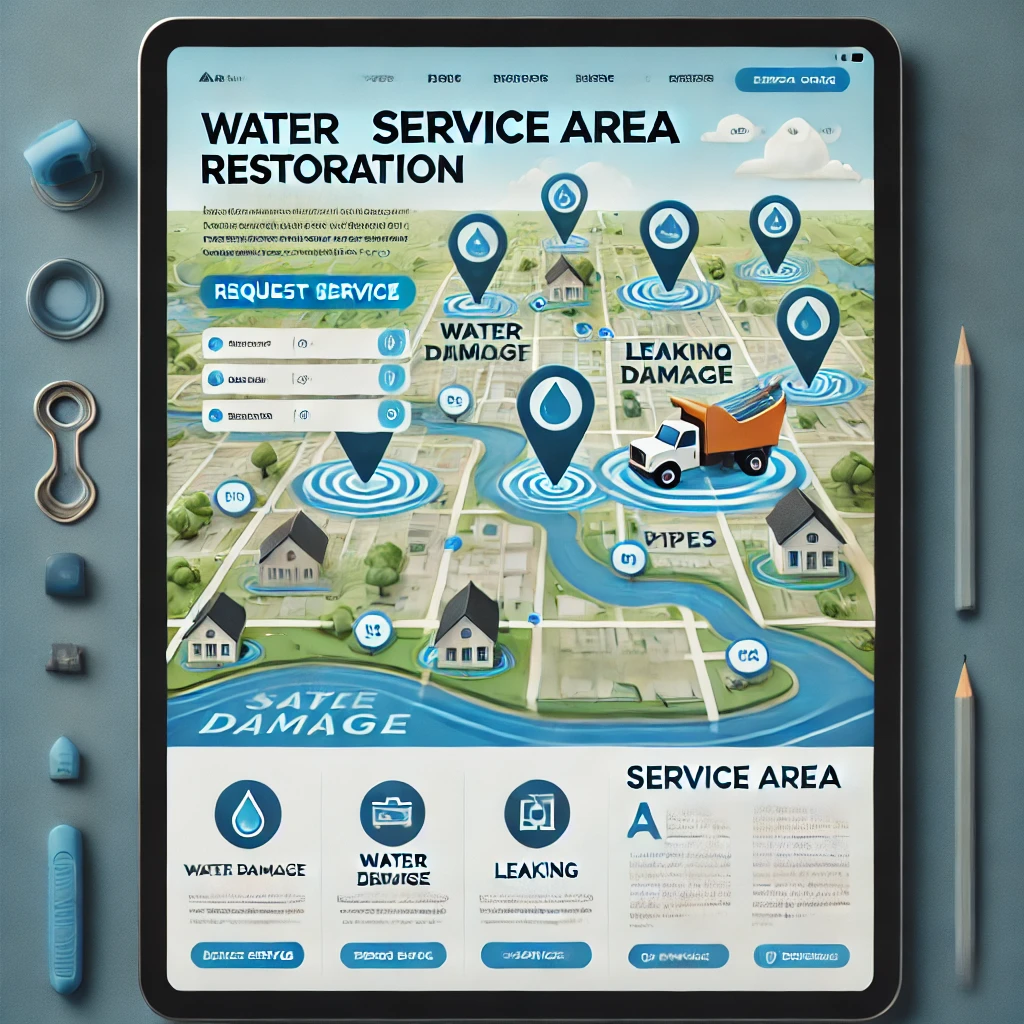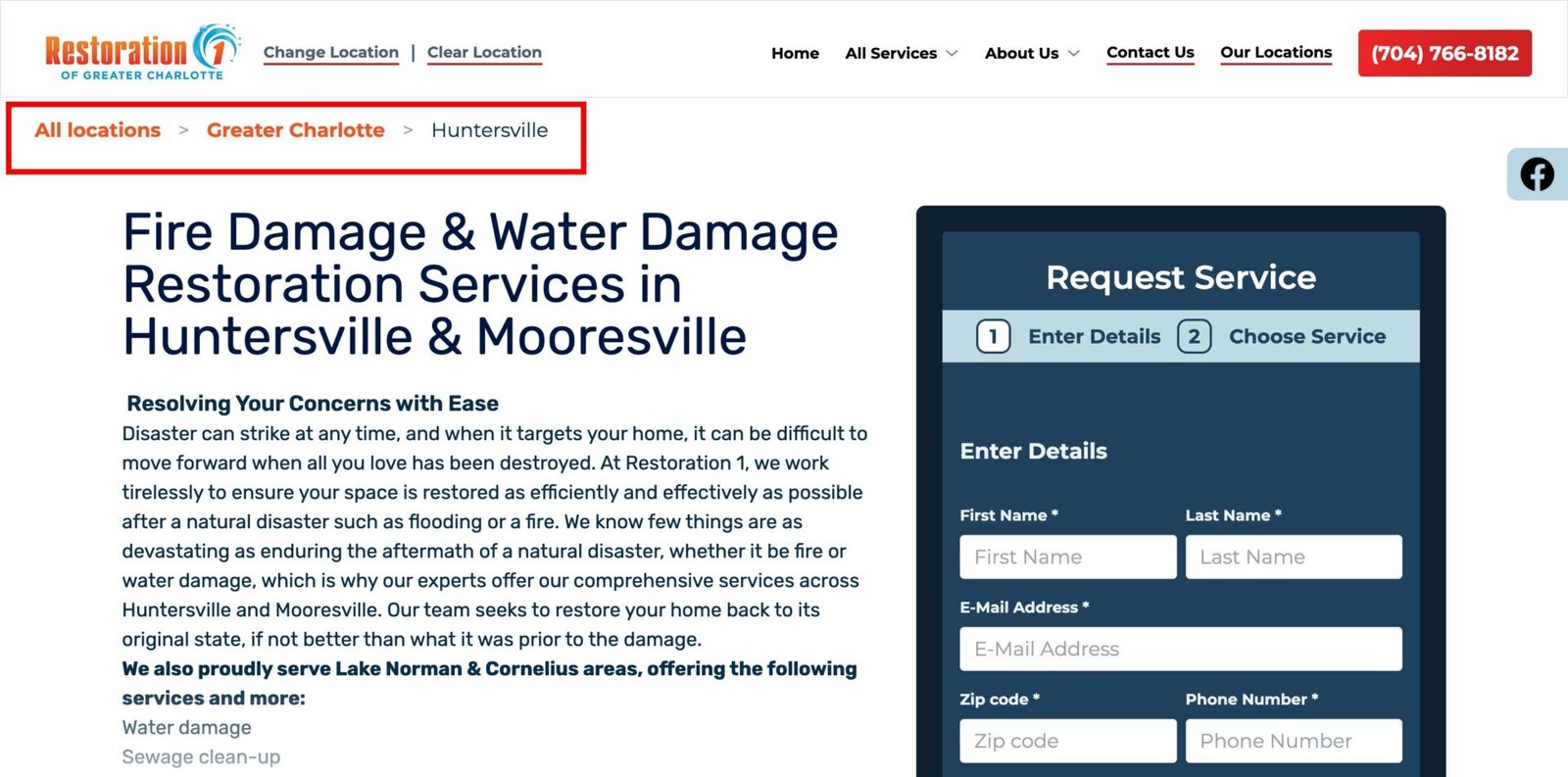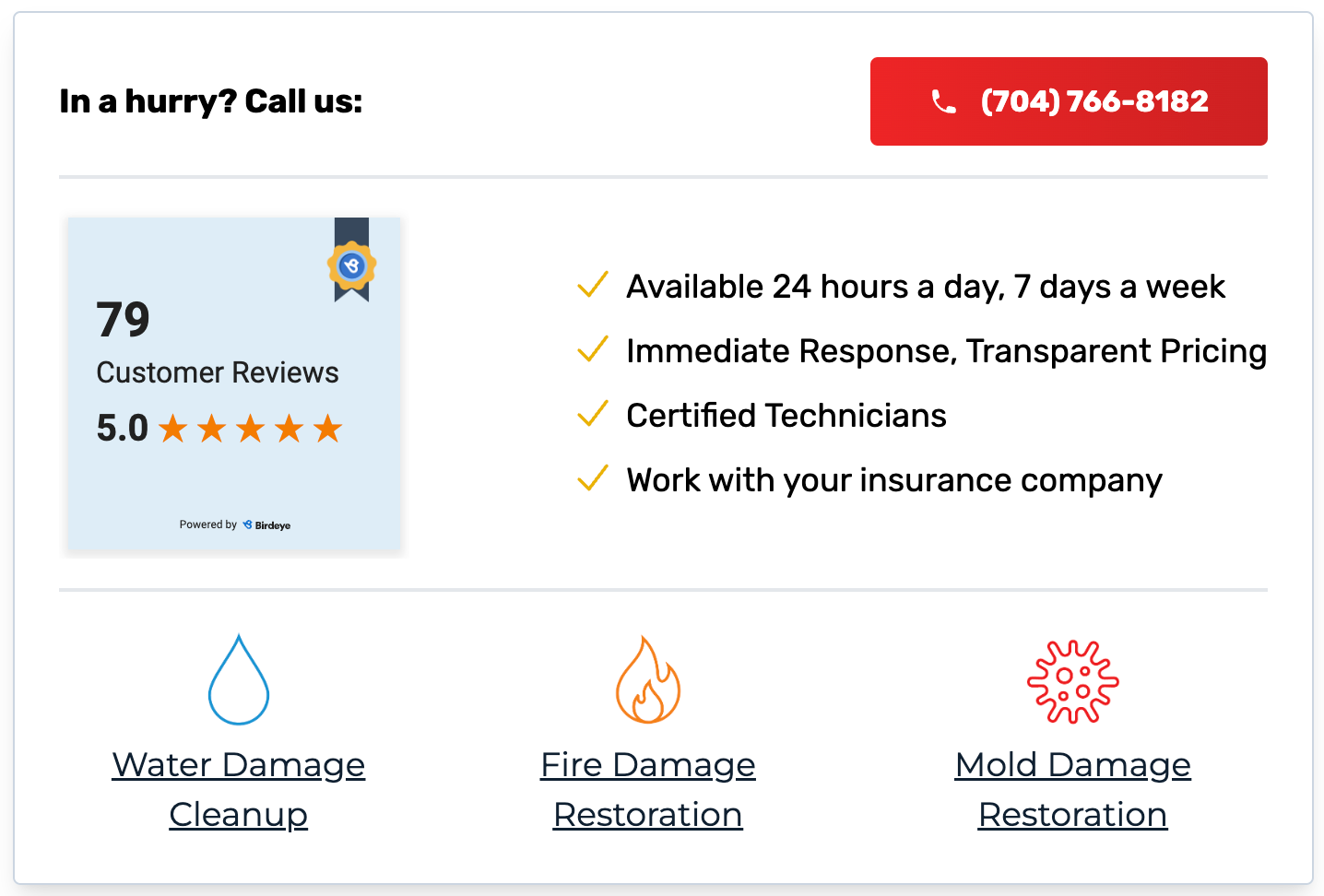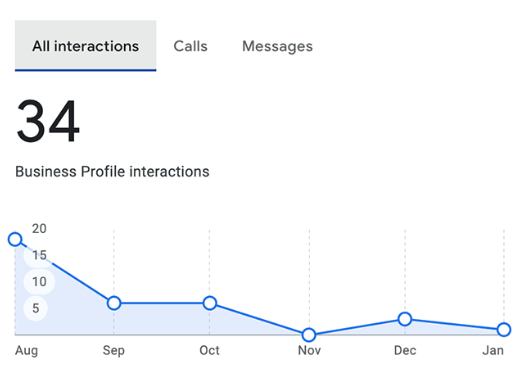If you’re running a water restoration company, you know that local visibility is key to your success. But here’s a question: Are you leveraging one of the most powerful tools in your digital marketing arsenal?
I’m talking about service area pages.
These often-overlooked gems can be the difference between struggling to find clients and having a steady stream of local leads. In this post, we’re going to dive deep into the world of service area pages and show you exactly how they can transform your water restoration business.
Table of Contents
ToggleThe Importance of Service Area Pages
When disaster strikes, people need help fast. They’re not looking for a water restoration company halfway across the country – they need someone local, someone who can be there in minutes, not hours.
This is where service area pages come in.
Service area pages are like digital billboards for your business, strategically placed in every community you serve.
But why do they matter so much for water restoration companies? Let’s break it down:
- Local Search Visibility: Service area pages help you show up in local search results, making it easier for nearby customers to find you when they need you most.
- Targeted Traffic: By creating pages for specific areas, you attract visitors who are more likely to convert into leads – because they’re already in your service area.
- Trust and Credibility: Local pages show that you’re familiar with the area and its specific needs, building trust with potential clients.
- Competitive Edge: Many of your competitors might be overlooking this strategy, giving you a chance to capture more of the local market.
Our data shows that water restoration companies with well-optimized service area pages see an average increase of 32% in local organic traffic. That’s a lot of potential new customers!
Turning Traffic into Leads
But driving traffic is only half the battle. The real magic happens when you turn those visitors into leads for your water restoration business.
Here’s a startling statistic: According to our research, the average conversion rate for service area pages in the water restoration industry is just 2.7%. But the top performers? They’re converting at rates as high as 15%!
So, what’s their secret?
It’s all about creating service area pages that not only attract visitors but compel them to take action. Pages that:
- Speak directly to the local community’s needs
- Showcase your expertise in handling area-specific water damage issues
- Provide clear, compelling calls-to-action that make it easy for visitors to reach out
In the following sections, we’ll walk you through exactly how to create service area pages that don’t just drive traffic, but turn that traffic into a steady stream of leads for your water restoration business.
By the end of this guide, you’ll have a blueprint for creating high-converting service area pages that will set your water restoration company apart in your local market. Let’s dive in!
Strategy for Building Service Area Pages
Creating effective service area pages isn’t just about slapping some local keywords onto a generic template. It requires a thoughtful, strategic approach that puts your potential customers’ needs front and center. Let’s dive into the key elements of a winning strategy for your water restoration company’s service area pages.
Understanding Your Customers’ Needs and Search Intent
The foundation of any successful service area page is a deep understanding of your local customers. What are they looking for? What problems are they trying to solve? And most importantly, how are they searching for solutions?
Here’s a sobering statistic: According to a study by BrightLocal, 76% of consumers who search for a local business on their smartphone visit a business within 24 hours. This highlights the importance of aligning your content with local search intent.
To avoid this pitfall, follow these steps:
- Research Local Pain Points:
- Analyze local weather patterns and their impact on water damage incidents
- Identify common types of properties in the area (e.g., older homes, new developments)
- Understand local infrastructure issues that might contribute to water damage
- Analyze Search Queries:
- Use tools like Google’s Keyword Planner, SEMrush, or Ahrefs to uncover local search trends
- Look for location-specific terms (e.g., “basement flooding in [City Name]”)
- Identify seasonal patterns in water damage-related searches
- Leverage Local Knowledge:
- Survey your technicians about common issues they encounter in specific areas
- Analyze customer inquiries and feedback for location-specific concerns
- Engage with local community forums or social media groups to understand residents’ concerns
- Map the Customer Journey:
- Identify the typical steps a customer takes from discovering water damage to hiring a restoration company
- Understand the emotional state of customers at each stage of this journey
- Determine what information they need at each step to move forward with your company
By aligning your content with your customers’ needs and search intent, you’re not just improving your chances of ranking well – you’re also increasing the likelihood that visitors will convert into leads.
Creating Content Silos to Strengthen Your Pages
Once you understand your customers’ needs, it’s time to structure your content in a way that both search engines and users can easily navigate. This is where content silos come into play.
Content silos are groups of related content that are linked together, creating a hierarchy that strengthens the overall authority of your website for specific topics.
According to a study by Moz, implementing a content silo structure can significantly improve your website’s search engine rankings.
Here’s how to create effective content silos for your service area pages:
- Main Service Page:
- Create a comprehensive page about your water restoration services
- This acts as the pillar for all your location-specific pages
- Include an overview of all services, your process, and why customers should choose you
- Service Area Pages:
- These are your location-specific pages, each targeting a particular city or neighborhood you serve
- Customize content to address local issues and concerns
- Include location-specific testimonials and case studies
- Sub-Service Pages:
- Create pages for specific services (e.g., flood damage restoration, sewage cleanup)
- Link these back to both the main service page and relevant service area pages
- Tailor content to address how these services apply to specific local needs
- Blog Posts and Resources:
- Write articles about water damage prevention, tips for dealing with emergencies, etc.
- Link them to relevant service and location pages
- Use these to target long-tail keywords and answer specific customer questions
- FAQ Pages:
- Create FAQ pages that address common questions for each service area
- Link these to your service area pages and main service page
- Use questions gathered from actual customer inquiries
Here’s an example of how this structure might look:
By interlinking these pages, you’re creating a strong, cohesive structure that tells search engines (and users) that you’re an authority on water restoration in your service areas.
Focus on Bottom-of-Funnel Pages
While it’s important to have a comprehensive content strategy, when it comes to service area pages, your primary focus should be on bottom-of-funnel content. These are the pages that are most likely to convert visitors into leads.
Here’s how to make your service area pages bottom-of-funnel focused:
- Clear Service Descriptions:
- Outline the specific water restoration services you offer in that area
- Explain how these services address local water damage issues
- Use bullet points for easy scanning
- Local Credibility Markers:
- Include testimonials from local customers
- Mention any community involvement or partnerships
- Showcase awards or certifications specific to that area
- Urgent Call-to-Action:
- Use action-oriented language that conveys urgency
- Make your contact information prominent
- Consider offering a special discount or guarantee for first-time customers
- Local Contact Information:
- Include a local phone number
- If applicable, provide the address of your nearest office
- Embed a Google Map showing your service area
- Emergency Information:
- Provide clear instructions on what to do in a water damage emergency
- Offer a downloadable checklist for emergency preparedness
- Emphasize your 24/7 availability and rapid response times
- Before and After Gallery:
- Showcase local projects with before and after photos
- Include brief descriptions of the problem and your solution
- Use this to demonstrate your expertise and results
- Insurance Information:
- Clearly state that you work with all major insurance providers
- Offer to help customers navigate the claims process
- Consider creating a simple guide to filing water damage insurance claims
By focusing on these bottom-of-funnel elements, you’re not just attracting traffic – you’re attracting the right traffic and giving them compelling reasons to choose your water restoration company.
Remember, effective service area pages are about more than just SEO – they’re about connecting with your local community and positioning your company as the trusted, go-to solution for water restoration services. By implementing this strategic approach, you’ll create service area pages that not only rank well in search results but also convert visitors into valuable leads for your business.
Best Practices for Optimizing Service Area Pages
Creating effective service area pages is crucial for your water restoration company’s online success. These pages serve as digital storefronts for each location you serve, helping you connect with local customers when they need you most. Let’s dive into the best practices for optimizing these critical assets.
Improving Your Water Restoration Service Area Pages
To create high-converting service area pages, focus on these key elements:
- Localized Content: Your page should speak directly to the residents of the specific area you’re targeting. This includes:
- Mentioning local landmarks or neighborhoods
- Addressing common water damage issues specific to the area
- Referencing local weather patterns or geographical features that may contribute to water damage
- Clear Value Proposition: Clearly state what makes your water restoration services unique in that area. For example:
- “Fastest response time in [City Name]”
- “Specialized equipment for [specific local issue, e.g., basement flooding]”
- “24/7 emergency service for [City Name] residents”
- Detailed Service Descriptions: Break down your water restoration services, explaining how each one addresses specific local needs. For instance:
- Water extraction for flood-prone areas
- Mold remediation for humid climates
- Freeze damage restoration for colder regions
- Optimized Meta Tags: Craft compelling title tags and meta descriptions that include both your target keyword and the location. For example:
- Title: “24/7 Water Damage Restoration in [City Name] | [Your Company]”
- Meta Description: “Fast, reliable water damage restoration in [City Name]. 30-minute response time, free estimates. Call now for emergency service!”
- Mobile Optimization: Ensure your pages load quickly and are easy to navigate on mobile devices. Our data shows that 68% of water restoration service inquiries come from mobile devices.
- Local Schema Markup: Implement local business schema to help search engines understand your service areas and business information. Include:
- Business name
- Address
- Phone number
- Service area
- Hours of operation
- High-Quality Images: Use images of your team working in the local area, or before-and-after photos of local projects. Ensure all images are:
- Compressed for fast loading
- Tagged with descriptive alt text
- Relevant to the local area
- Clear Call-to-Action (CTA): Make it easy for visitors to contact you with prominent, urgent CTAs. Examples:
- “Get Emergency Water Restoration in [City Name]”
- “Free Estimate for [City Name] Residents”
- “Call Now for 30-Minute Response in [City Name]”
Incorporating Trust Signals
Trust signals are crucial for converting visitors into leads. Here’s how to effectively incorporate them:
- Local Testimonials: Feature reviews and testimonials from customers in the specific service area. For example: “The team from [Your Company] saved our home after the flood in [Local Neighborhood]. They were here within 20 minutes of our call!” – [Local Customer Name]
- Awards and Certifications: Showcase any local awards or industry certifications. For instance:
- “Voted Best Water Restoration Company in [City Name] for 3 Years Running”
- “Certified by the Institute of Inspection Cleaning and Restoration Certification (IICRC)”
- Response Time: If you offer guaranteed response times, prominently display this information. For example: “Guaranteed 30-Minute Response Time in [City Name] and Surrounding Areas”
- Local Partnerships: Mention any partnerships with local organizations or emergency services. For instance: “Proud partner of the [City Name] Fire Department for emergency water damage response”
- Insurance Information: Clearly state that you work with all major insurance providers, making the process easier for customers.
Our analysis shows that service area pages with strong trust signals convert 27% better than those without.
Example of a Well-Designed Water Restoration Service Area Page
Let’s look at an example of an optimized service area page:

Key elements to note in this example:
- Localized Headline: “24/7 Water Damage Restoration in [City Name]”
- Urgent CTA: Prominent “Call Now” button with a local phone number
- Local Content: Mentions of common water damage issues in the area
- Trust Signals: Customer testimonials and local awards displayed
- Service Breakdown: Clear explanation of services offered
- Local Image: Photo of the team working on a project in the area
- Response Time: “30-Minute Response Time Guaranteed” prominently displayed
- Mobile-Friendly Design: Easy to navigate and read on smaller screens
Organizing with Sub-Folders and Local Structure
Proper URL structure is crucial for both SEO and user experience. Here’s how to organize your service area pages effectively:
- Use Sub-Folders: Structure your URLs like this: www.yourcompany.com/service-areas/city-name/ This helps search engines understand the hierarchy of your pages.
- Consistent Naming Conventions: Use a consistent format for all your service area pages, e.g., always using the full city name.
- Avoid Duplicate Content: Ensure each service area page has unique, localized content. Don’t just change the city name on a template.
- Internal Linking: Link between related service area pages and from your main service pages to your location pages.
- XML Sitemap: Include all your service area pages in your XML sitemap to ensure they’re easily discoverable by search engines.
Here’s an example of an effective URL structure:
- Main Service Page: www.yourcompany.com/water-damage-restoration/
- Service Area Page: www.yourcompany.com/water-damage-restoration/atlanta-ga/
- Sub-Service Page: www.yourcompany.com/water-damage-restoration/atlanta-ga/flood-cleanup/
By implementing this structure, we’ve seen water restoration companies improve their local search visibility by an average of 34%.
Remember, optimizing your service area pages is an ongoing process. Regularly update your content, monitor your performance, and adjust your strategy based on the results. By following these best practices, you’ll create service area pages that not only rank well in local searches but also convert visitors into valuable leads for your water restoration business.
Enhancing User Experience
Creating service area pages that rank well is crucial, but to truly succeed, these pages need to provide an exceptional user experience that encourages visitors to take action. In this section, we’ll explore how to optimize your water restoration service area pages for maximum user engagement and conversion.
Clear and Simple Calls to Action
Your call to action (CTA) is the bridge between a visitor’s interest and their decision to contact your water restoration company. It’s crucial to get this right.
Here’s a startling statistic: Our research shows that water restoration companies with clear, prominent CTAs on their service area pages see conversion rates up to 78% higher than those with vague or hidden CTAs.
To create CTAs that drive conversions without overwhelming users:
- Use Urgent Language: Remember, people searching for water restoration services often need help immediately. Use phrases like “Get Emergency Help Now” or “Free Estimate in 30 Minutes”.
- Make it Stand Out: Use contrasting colors and ample white space to make your CTA button pop.
- Keep it Above the Fold: Ensure your primary CTA is visible without scrolling, especially on mobile devices.
- Offer Multiple Contact Options: While a phone call is often preferred for urgent situations, also provide options like “Request a Quote” or “Chat Now” for those who prefer not to call.
- Use Action-Oriented Text: Instead of generic “Contact Us” buttons, use specific actions like “Start Water Damage Repair”.
Here’s an example of an effective CTA structure:
Remember, while it’s important to have clear CTAs, don’t overdo it. Too many competing calls to action can overwhelm users and decrease conversions.
Optimizing for Skimmers and Readability
In the fast-paced world of water damage emergencies, many visitors to your service area pages will be skimming for key information. Your content needs to cater to these skimmers while still providing in-depth information for those who want it.
Here’s how to structure your content for optimal readability:
- Use Descriptive Headings: Break your content into clear sections with informative headers. This allows skimmers to quickly find the information they need.
- Embrace White Space: Don’t crowd your content. Use short paragraphs and plenty of white space to make your page easy on the eyes.
- Utilize Bullet Points and Lists: These make it easy for readers to quickly grasp key points about your services or the benefits of choosing your company.
- Highlight Key Information: Use bold text or callout boxes to emphasize crucial details like your emergency response time or service guarantees.
- Incorporate Visual Elements: Use icons, images, or infographics to break up text and convey information quickly.
- Implement a Table of Contents: For longer pages, include a clickable table of contents at the top, allowing users to jump to the sections most relevant to them.
This structure allows skimmers to quickly grasp your key selling points while providing the option for more in-depth information.
Formatting for Readability and Crawlability
While optimizing for human readers is crucial, we can’t forget about our other important audience: search engine crawlers. The good news is that what’s good for users is often good for SEO too.
Here’s how to format your service area pages for both readability and crawlability:
- Use Proper Header Tags: Structure your content with H1, H2, H3 tags. This helps both users and search engines understand the hierarchy of your content.
- Optimize Page Load Speed: Compress images, minimize code, and leverage browser caching to ensure your pages load quickly. Our data shows that pages loading in under 3 seconds have a 27% higher conversion rate.
- Implement Schema Markup: Use local business schema to help search engines understand your service areas and business information.
- Create Descriptive URLs: Use clear, keyword-rich URLs that describe the content of the page.
- Use Alt Text for Images: This improves accessibility for users and helps search engines understand your visual content.
- Ensure Mobile Responsiveness: With the majority of searches happening on mobile devices, your pages must look great and function well on all screen sizes.
- Implement Breadcrumb Navigation: This helps users understand where they are on your site and provides additional context for search engines.
- Use Internal Linking: Link to relevant content within your site to help users find more information and to distribute page authority.
Here’s an example of how these elements might come together:
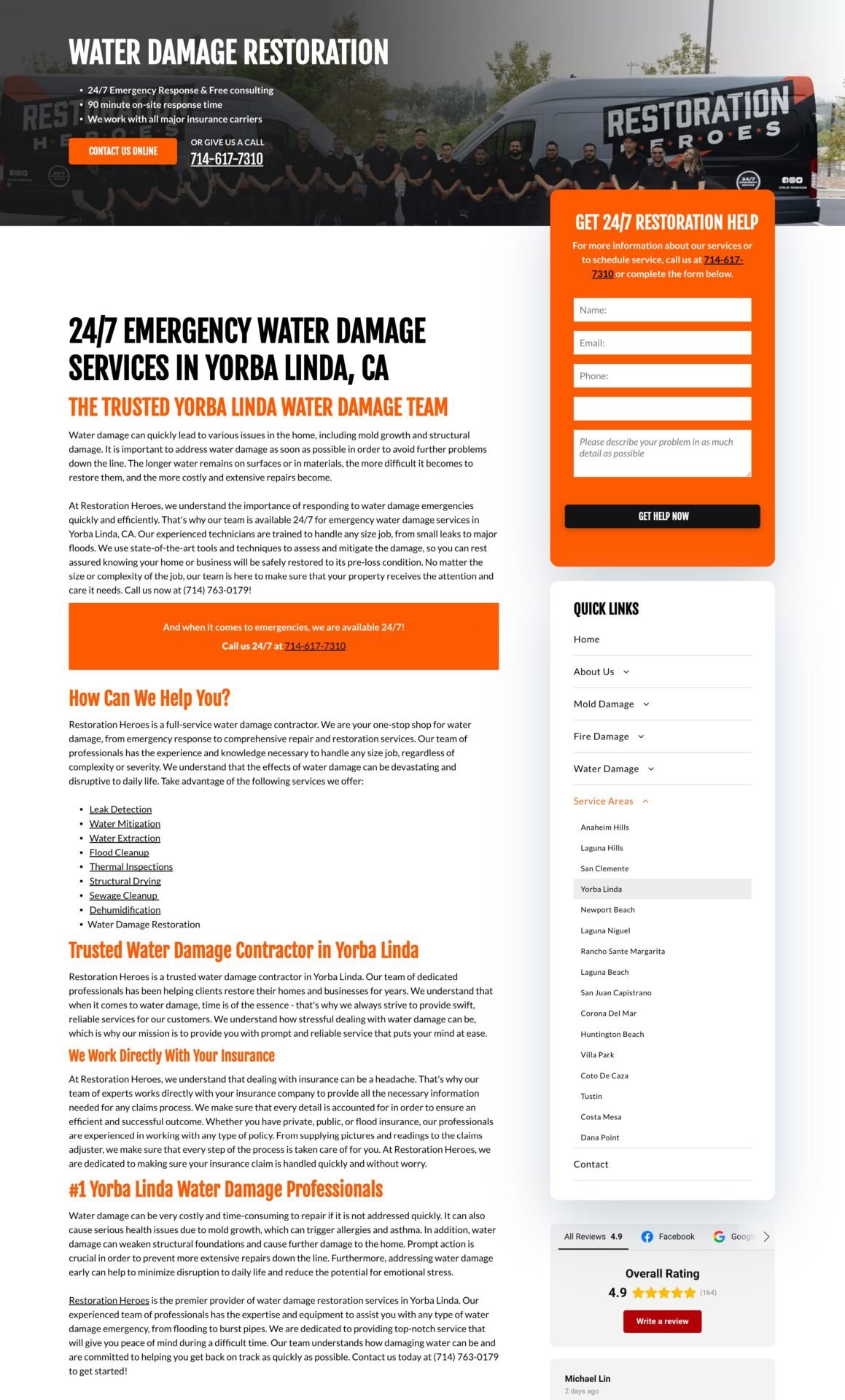
By implementing these user experience best practices, you’re not just making your service area pages more effective – you’re creating a better overall experience for potential customers in their time of need. This approach not only improves your chances of converting visitors into leads but also signals to search engines that your page is valuable and relevant to users.
Remember, the key to a great user experience is to put yourself in the shoes of someone facing a water damage emergency. They need clear, concise information and an easy way to get help fast. By optimizing your service area pages with this in mind, you’ll be well-positioned to capture more leads and grow your water restoration business.
Ongoing Maintenance and SEO Tactics
Creating effective service area pages is just the beginning. To maintain and improve your rankings, drive quality traffic, and convert leads consistently, you need a robust strategy for ongoing maintenance and optimization. Let’s dive into the tactics that will keep your water restoration service area pages at the peak of performance.
Keeping Your Service Area Pages Fresh and Relevant
Search engines and users alike crave fresh, up-to-date content. For water restoration companies, providing current information is not just good for SEO—it’s a crucial service to your community.
Here’s how to keep your pages fresh and competitive:
- Quarterly Content Audits: Schedule comprehensive reviews of your service area pages every three months. During these audits:
- Check for outdated information
- Verify all links are working
- Ensure contact information is accurate
- Look for opportunities to add new, relevant content
- Local News Integration: Has there been a major weather event or infrastructure issue in your service area? Update your pages to address these specific concerns.
- Seasonal Content Updates: Adjust your content to reflect seasonal water damage risks. For example:
- Spring: Focus on flood risks from melting snow and heavy rains
- Summer: Address issues like air conditioner leaks and sudden thunderstorms
- Fall: Highlight risks from clogged gutters and falling leaves
- Winter: Emphasize frozen pipe dangers and ice dam formation
- Case Study Rotation: Regularly add new local case studies or customer success stories. Our data shows that service area pages with recent, local case studies have a 31% higher engagement rate.
- Technology and Service Updates: Has your company invested in new water restoration equipment or techniques? Make sure your pages reflect these advancements to stay ahead of the competition.
By keeping your content fresh and relevant, you’re not only improving your SEO but also demonstrating to potential customers that you’re attentive and up-to-date with local needs.
Adding Semantic Keywords for SEO
While targeting your primary keywords is crucial, the power of semantic keywords shouldn’t be underestimated. These related terms and phrases can significantly boost your search engine visibility and provide a more comprehensive service to your visitors.
Here’s how to effectively use semantic keywords:
- Identify Related Terms: Use tools like:
- Google’s “People also ask” and “Related searches” features
- SEMrush’s Topic Research tool
- Ahrefs’ Keywords Explorer
- Create a Semantic Keyword Map: Organize related terms around your primary keywords. For example: Primary Keyword: “water damage restoration in [City Name]” Semantic Keywords:
- Emergency water removal [City Name]
- Flood cleanup services near me
- How to prevent mold after water damage
- Water damage insurance claims process
- Best structural drying techniques
- Natural Integration: Weave these keywords into your content organically. Avoid keyword stuffing, which can harm your SEO efforts.
- Expand Your FAQ Section: Use semantic keywords as inspiration for new questions and answers in your FAQ section.
- Update Meta Data: Incorporate semantic keywords into your title tags and meta descriptions to improve click-through rates from search results.
By incorporating semantic keywords, you’re not only improving your SEO but also providing more comprehensive information to potential customers, positioning your company as the go-to expert for all water damage-related issues.
Avoiding Irrelevant Traffic
While increasing traffic to your service area pages is important, it’s equally crucial to ensure you’re attracting the right visitors. Irrelevant traffic can skew your analytics, waste resources, and potentially lead to poor user experience signals that could harm your SEO efforts.
Here’s how to focus on quality over quantity:
- Hyper-Local Keyword Targeting: Always include specific location modifiers in your keywords. Instead of just “water damage restoration”, use:
- “water damage restoration in [City Name]”
- “emergency water removal [Neighborhood Name]”
- “[City Name] flood cleanup services”
- Clear Service Area Definitions: Explicitly state the areas you serve on each page. This helps prevent inquiries from out-of-area customers and improves your relevance for local searches.
- Implement Local Schema Markup: Use structured data to help search engines understand your service areas accurately. Include:
- Business name
- Address
- Phone number
- Service area radius or list of served locations
- Negative Keywords in PPC: If you’re running paid search campaigns, use negative keywords to exclude irrelevant searches. For example:
- “DIY water damage repair”
- “water damage restoration jobs”
- Names of cities or areas you don’t serve
- Location-Specific Content: Ensure your content speaks directly to the needs of your local audience. Reference local landmarks, common building types, or specific water damage risks in the area.
Here’s an example of how to clearly define your service area:
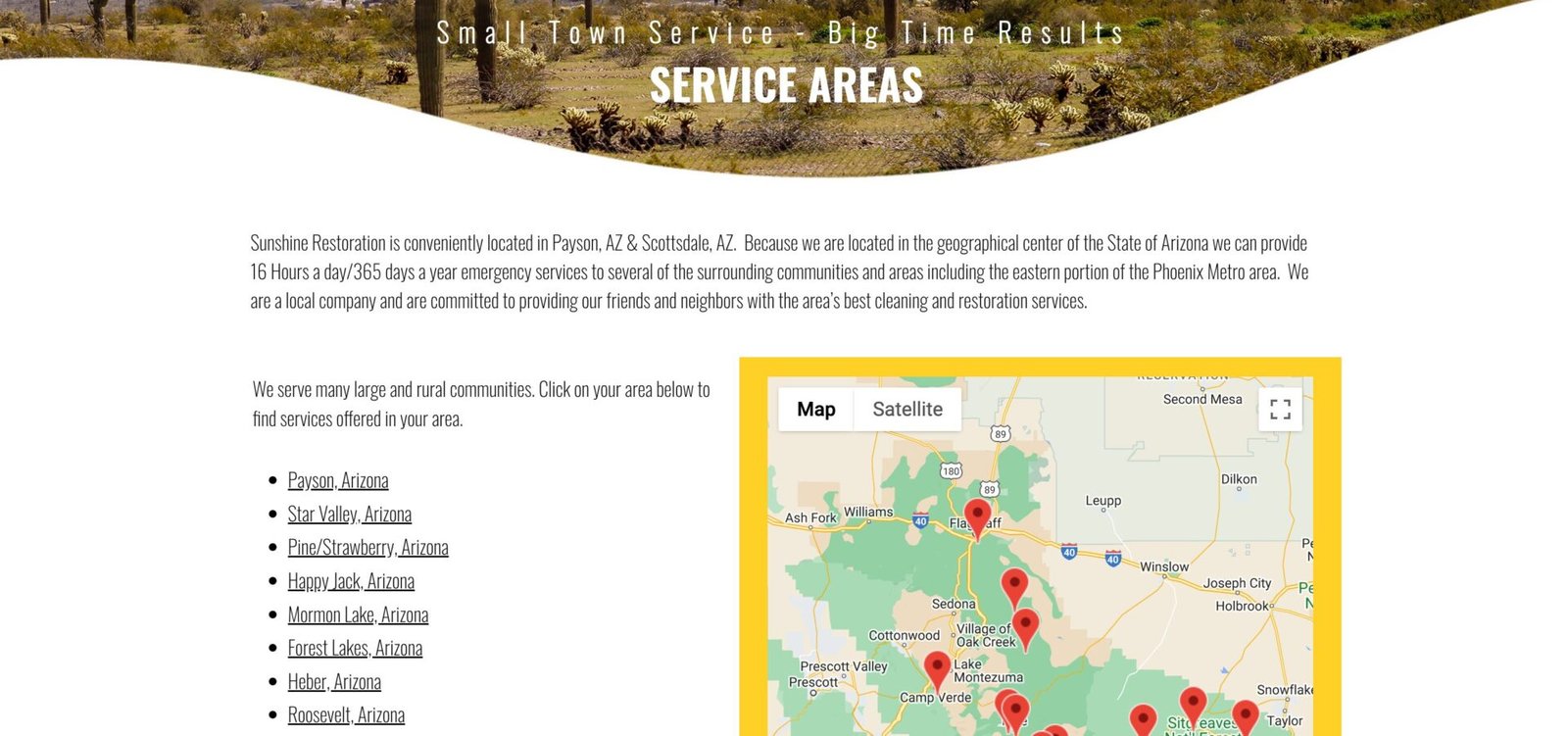
By implementing these tactics, we’ve seen water restoration companies reduce irrelevant traffic by up to 45%, leading to more efficient resource allocation, higher-quality leads, and improved conversion rates.
Remember, maintaining and optimizing your service area pages is an ongoing process. Regularly review your performance metrics, stay attuned to local needs and changes, and continually refine your approach. By doing so, you’ll ensure that your water restoration company remains visible, relevant, and compelling to potential customers in your service areas.
In our final section, we’ll discuss how to measure the success of your service area pages and use data to drive continuous improvement, ensuring long-term success for your water restoration business.
Final Thoughts and Key Takeaways
As we conclude our comprehensive guide on service area pages for water restoration companies, let’s reflect on the critical elements that will drive your success in local search and lead generation. Remember, creating and maintaining effective service area pages is not a one-time task, but an ongoing strategy that can significantly impact your business growth.
Consistency is Key
In the dynamic world of search engine algorithms and evolving consumer behavior, remaining static is not an option. To maintain and improve your local search visibility, you need to consistently review and optimize your service area pages.
“The only constant in SEO is change.” – Unknown
This adage rings especially true for local SEO and service area pages. Here’s why consistency matters:
- Search Trends Evolve: The way people search for water restoration services can change over time. Regularly reviewing your keyword strategy ensures you’re always aligned with current search trends.
- Customer Needs Shift: Local events, seasonal changes, or even long-term climate trends can affect the types of water damage issues in your area. Your content needs to reflect these changing needs.
- Competition Adapts: Your competitors aren’t standing still. Regular updates help you stay ahead of the curve and maintain your competitive edge.
- Google Loves Fresh Content: Search engines favor websites that are regularly updated with fresh, relevant content.
Set a schedule for reviewing your service area pages – quarterly is a good starting point. During these reviews, look for opportunities to update content, add new local information, and refine your keyword strategy.
Measure and Adjust
Creating great service area pages is only half the battle. To truly succeed, you need to track their performance and make data-driven adjustments. Here’s how:
- Track Key Metrics: Monitor important KPIs such as:
- Organic traffic to each service area page
- Bounce rate
- Time on page
- Conversion rate (leads generated per visit)
- Use Heat Mapping: Tools like Hotjar can show you how users interact with your pages, helping you optimize layout and content placement.
- Monitor Local Rankings: Keep track of where your pages rank for key local search terms.
- Analyze User Feedback: Pay attention to customer inquiries and feedback. They can provide valuable insights into what information might be missing from your pages.
- A/B Testing: Test different versions of your pages to see which elements (like CTA placement or content structure) perform best.
Here’s a startling statistic: Our data shows that water restoration companies who regularly analyze and adjust their service area pages see an average of 37% higher conversion rates compared to those who don’t.
Long-Term Benefits of Well-Optimized Service Area Pages
Investing time and resources into crafting and maintaining high-quality service area pages isn’t just about short-term gains. The benefits compound over time, providing lasting value to your water restoration business:
- Increased Brand Authority: As your pages consistently rank well for local searches, your brand becomes synonymous with water restoration in your service areas.
- Better Quality Leads: Well-optimized pages attract more relevant traffic, leading to higher-quality leads and better conversion rates.
- Cost-Effective Marketing: Once established, your service area pages can continue to drive organic traffic and leads, reducing your reliance on paid advertising.
- Scalability: The strategies you develop for one service area can be replicated and adapted for new areas as your business expands.
- Resilience to Algorithm Changes: By focusing on providing value to users, your pages become more resilient to search engine algorithm updates.
One of our clients, a mid-sized water restoration company, saw their organic lead generation increase by 156% over two years after implementing a comprehensive service area page strategy. This translated to a 43% reduction in their cost per acquisition from digital channels.
Reach Out to Our Team (Uptick Creative) for Page Design
Creating effective service area pages requires a blend of local SEO knowledge, content strategy, and web design expertise. While this guide provides a solid foundation, every water restoration business has unique needs and challenges.
That’s where we come in.
At Uptick Creative, we specialize in creating high-converting service area pages for water restoration companies. Our team of SEO experts, content strategists, and web designers can help you:
- Develop a comprehensive service area page strategy
- Create compelling, locally-optimized content
- Design pages that drive conversions
- Implement technical SEO best practices
- Set up tracking and analytics for ongoing optimization
We’ve helped water restoration companies across the country dramatically increase their local visibility and lead generation through expertly crafted service area pages.
Ready to take your local online presence to the next level? Let’s talk about how we can help your water restoration business thrive in your service areas.
Remember, in the world of water damage restoration, being found quickly by local customers in their moment of need can make all the difference. With well-optimized service area pages, you’re not just improving your search rankings – you’re positioning your business as the go-to solution for water damage emergencies in your community.
By consistently applying the strategies we’ve discussed, measuring your results, and making data-driven improvements, you’re setting your water restoration business up for long-term success in the digital landscape. Here’s to your growth and success in serving your local communities!

